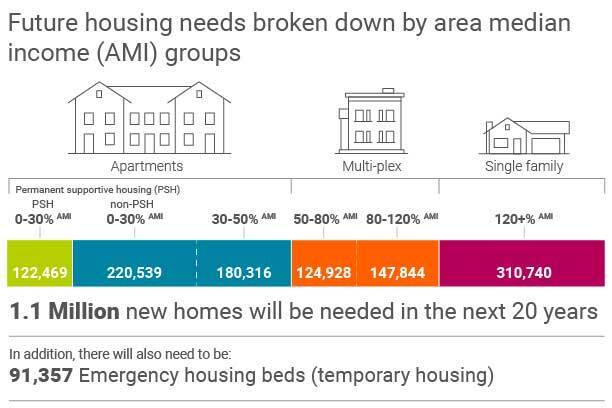The Washington State Department of Commerce on March 2 released its final housing needs projections, which suggest the state needs to add 1.1 million homes over the next 20 years — and more than half of those homes need to be affordable for residents at the lowest income levels.
Based on census data and the Office of Financial Management’s population projections, these final housing projections illustrate that Washington needs more than 50,000 new units annually to keep pace with expected population growth, according to the agency.
In 2021, the Growth Management Act framework that required the fastest-growing counties and cities to plan for a certain number of housing units based on projected population growth for the next 20 years was amended to also incorporate income levels. The update to the state’s planning framework requires communities to focus on affordability, a standard that housing and utilities should cost no more than 30% of household income.
Recent federal data suggests approximately 30% of Washingtonians are cost-burdened — paying more than that 30% for housing.
“Based on the large number of housing needs at the lower income bands, many communities will need to change the way they plan for housing and plan for more apartments, condominiums, moderate density housing such as middle housing, and accessory dwelling units,” said Dave Andersen, managing director of the Growth Management Services unit in a statement regarding the study. “Planning for housing in the next 20 years will require an inclusive and equity-driven approach if we are to meet the housing needs for all the residents at all income levels.”
According to the Department of Commerce, communities must plan for housing needs at all incomes, including emergency housing and permanent supportive housing — subsidized housing with support services — for people at risk of or experiencing homelessness.
The final housing numbers estimate the need for approximately 91,360 units of emergency housing by 2044 to ensure that people with unstable housing situations have a safety net, such as people in between jobs who cannot afford housing and young people exiting the foster care system.
“We used census and other best available data sources to identify existing housing, household incomes and household sizes, as well as best available homeless data and information about housing risk factors to develop a model to identify the housing that will be needed over the 20-year planning period,” said Tedd Kelleher, housing policy director in a statement.
“Every community in the state is experiencing housing pressures and needs to plan for enough housing so that everyone can live inside,” he added. “This housing will require significant local, state and federal investments to meet our state’s future housing needs, because it is difficult for the private market to produce housing for the lowest income brackets.”
Talk to us
Please share your story tips by emailing editor@kentreporter.com.
To share your opinion for publication, submit a letter through our website https://www.kentreporter.com/submit-letter/. Include your name, address and daytime phone number. (We’ll only publish your name and hometown.) Please keep letters to 300 words or less.

